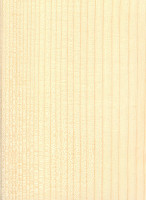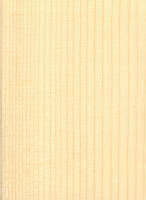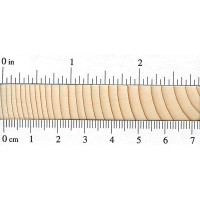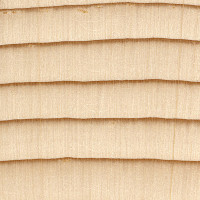 |
Common Name(s): Engelmann Spruce Scientific Name: Picea engelmannii Distribution: Western North America Tree Size: 130 ft (40 m) tall, 3 ft (1 m) trunk diameter Average Dried Weight: 24 lbs/ft3 (385 kg/m3) Specific Gravity (Basic, 12% MC): .33, .39 Janka Hardness: 390 lbf (1,740 N) Modulus of Rupture: 9,010 lbf/in2 (62.2 MPa) Elastic Modulus: 1,369,000 lbf/in2 (9.44 GPa) Crushing Strength: 4,560 lbf/in2 (31.5 MPa) Shrinkage: Radial: 3.8%, Tangential: 7.1%, Volumetric: 11.0%, T/R Ratio: 1.9 |
Color/Appearance: Engelmann Spruce is usually a cream to almost white color, with an occasional hint of red.
Grain/Texture: Engelmann Spruce has a fine, even texture, and a consistently straight grain; numerous small knots are also common.
Rot Resistance: Heartwood is rated as being slightly resistant to non-resistant to decay.
Workability: Easy to work, as long as there are no knots present. Glues and finishes well, though it can give poor (blotchy and inconsistent) results when being stained due to its closed pore structure. A sanding sealer, gel stain, or toner is recommended when coloring Spruce.
Odor: No characteristic odor.
Allergies/Toxicity: Although severe reactions are quite uncommon, Spruce in the Picea genus has been reported as a sensitizer. Usually most common reactions simply include skin irritation and/or respiratory disorders. See the articles Wood Allergies and Toxicity and Wood Dust Safety for more information.
Pricing/Availability: Construction grade spruce is cheap and easy to find. However, old growth and/or quartersawn clear pieces—free from knots—can be more expensive. Quartersawn billets of instrument-grade Engelmann Spruce can easily exceed the cost of most all domestic hardwoods in terms of per board-foot cost.
Sustainability: This wood species is not listed in the CITES Appendices, and is reported by the IUCN as being a species of least concern.
Common Uses: Construction lumber, sheathing, railroad ties, wood pulp, and papermaking; also used occasionally in place of Sitka Spruce on guitars and other musical instrument soundboards.
Comments: Engelmann Spruce is slightly lighter and weaker than Sitka Spruce, but still has a good stiffness-to-weight ratio.
 |
 |
 |
 |





I wouldn’t use spruce for a chair. I would search for a wood that rates at least 1200 on the Janka Scale.
I am working on a prototype for a beach chair and I really need someone to tell me if Engelmann Spruce would be the right wood to use. I did a search for strongest, lightest wood and spruce came up. I have a lot of experience with many woods from Afromosia to Zebrawood but don’t know a lot about softwoods. Can someone give me some advice please?